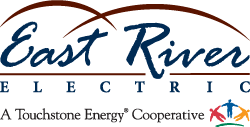When was the last time you took a close look at your electric bill? If you’re like most, you probably don’t review it often and, when you do, it can be tempting to just scan and focus on the bottom line. We get it, time is short, and life is busy. But it’s important to gain a good understanding of what the charges on your electric bill mean.
A lot goes on behind the scenes within our cooperative family to calculate electric rates—from the wholesale level to the retail level— and this article breaks down how everything comes together to create the amount you pay each month.
The Journey of Electricity
Understanding all that goes into your electric bill starts with learning how electricity is made and how it’s delivered to your home. Before your local electric co-op can send electricity to your home, that electricity must be created by a generation unit. In our cooperative network, the electricity you receive at your home is a combination of energy created by wind, hydropower, natural gas, coal or other fuels. Electricity is generated at the same moment it’s needed and wholesale power providers like East River Electric Power Cooperative and Basin Electric Power Cooperative have a watchful eye on the electric system around the clock making sure your lights come on when you flip the switch. Depending on the weather, the generation mix can vary (if the wind is blowing, there’s more wind on the system; if the wind isn’t blowing, more traditional energy sources are used to meet electric usage).
Once the electricity has been generated, it travels over high-voltage transmission lines to substations, where the voltage is reduced to a lower level. The electricity then travels over distribution power lines and the voltage is reduced again to safely find its way into your home. In our cooperative network, East River Electric owns and maintains the substations and transmission power lines. When severe weather strikes, our local crews in South Dakota and Minnesota are at the ready to quickly make repairs and restore power to the grid.
Understanding Your Power Bill
Now, returning to your power bill, the first thing you might see is a facility or base fee. This is one of three types of costs on your bill. Rates are set based on cost of service studies done at the local co-op to cover its costs. The facility fee is a set amount you pay each month to cover your share of the onsite costs of your distribution cooperative; including metering, billing and local infrastructure. It’s a necessary service charge so all members pay their fair share of the fixed costs for operating the cooperative. All members pay the facility fee regardless of how much energy they consume so they all contribute equally to help keep the cooperative running. In other words, the facility charge that you see on your monthly bill funds the local distribution cooperative and is not directly related to the cost of East River Electric’s wholesale power. The facility charge can vary by cooperative and determined by the number of members who are supporting those costs. A cooperative with 2 meters per mile of line will likely have a higher facility fee than a cooperative with 4 meters per mile of line because the more rural co-op will have more infrastructure and fewer consumers in which to spread the cost.
The next two types of costs are usually combined as an energy fee on your bill, which is based on your electric usage each month. The energy you use at your home or farm is metered and charged on a kilowatt-hour (kWh) basis. The kWh rate is made up of wholesale power costs, including the generation and transmission needed to get the power from a generation unit to your local cooperative. A lot of things are considered when setting a wholesale power rate – construction costs, interest rates, regulatory requirements, depreciation of assets, materials, labor and more. Some of those costs are controllable, others are not.
One great benefit of being a member-owner of a not-for-profit electric cooperative is that you have a say in how our cooperative network is run. East River Electric is governed by a board of directors made up of representatives from our member systems. East River is also cost-based, so our rates are set by our members in a way that allows us to collect enough revenue to pay for providing power, with a small margin to meet lending requirements and plan for any unexpected costs. Those margins (money made over the cost of providing power) are given back to the members who own the cooperative. That’s something you won’t see from a for-profit company.
Generating and distributing power is an intricate business and involves a lot more than the generation of electricity, but rest assured that East River Electric will always meet the necessary demand to provide safe, reliable and affordable electricity to the region’s consumers.

